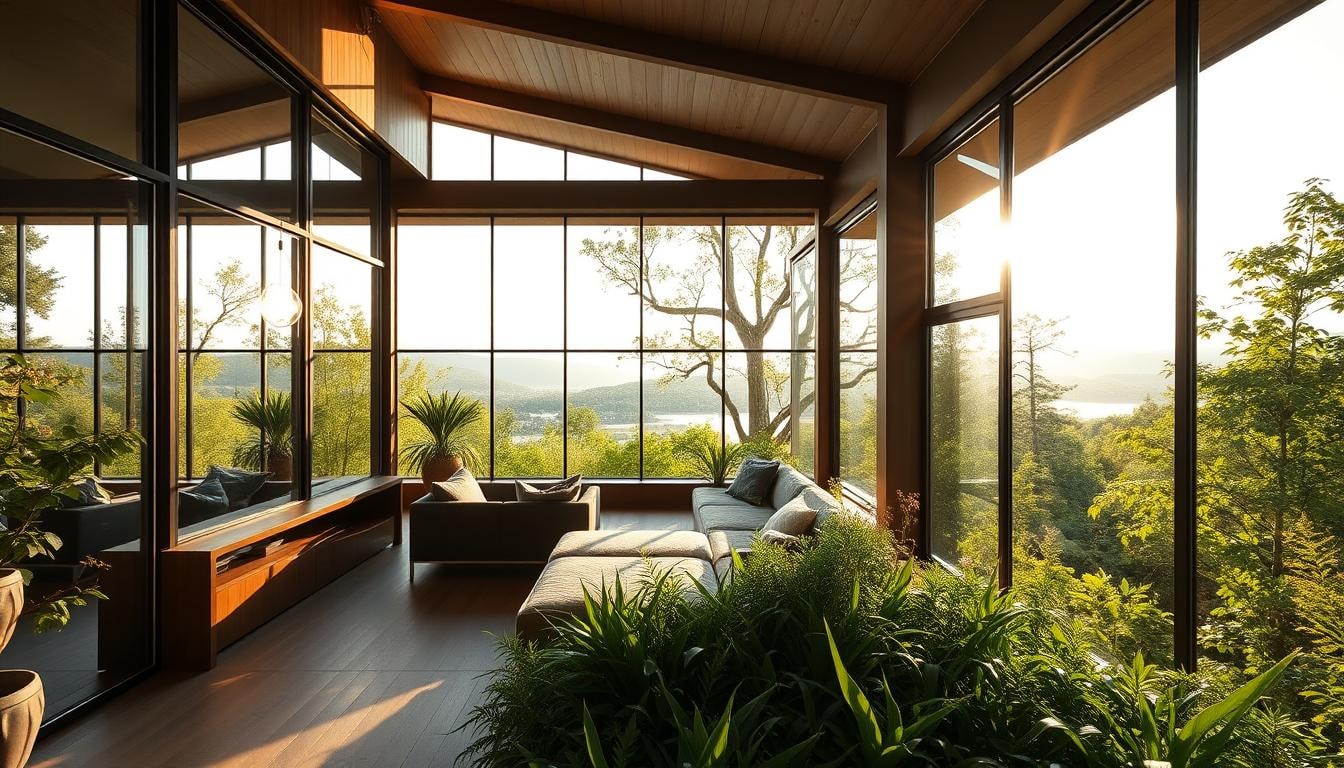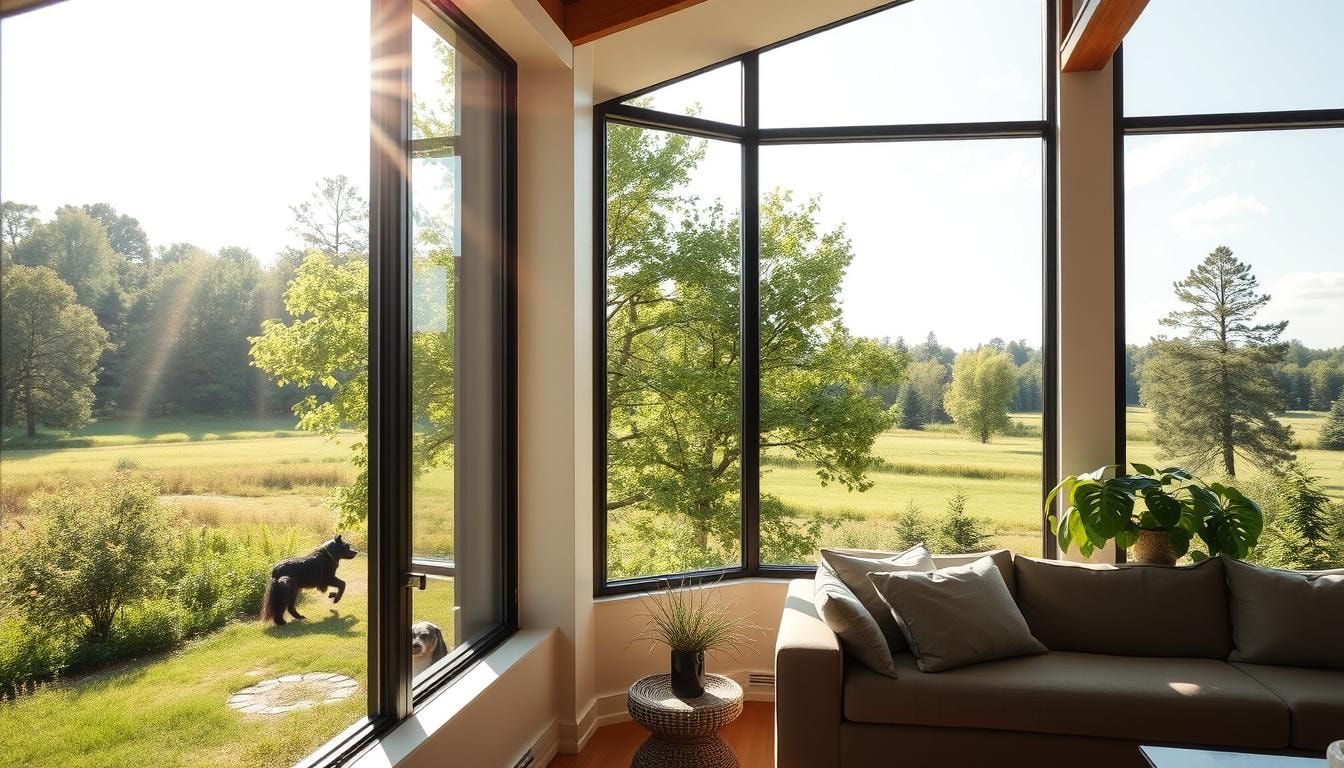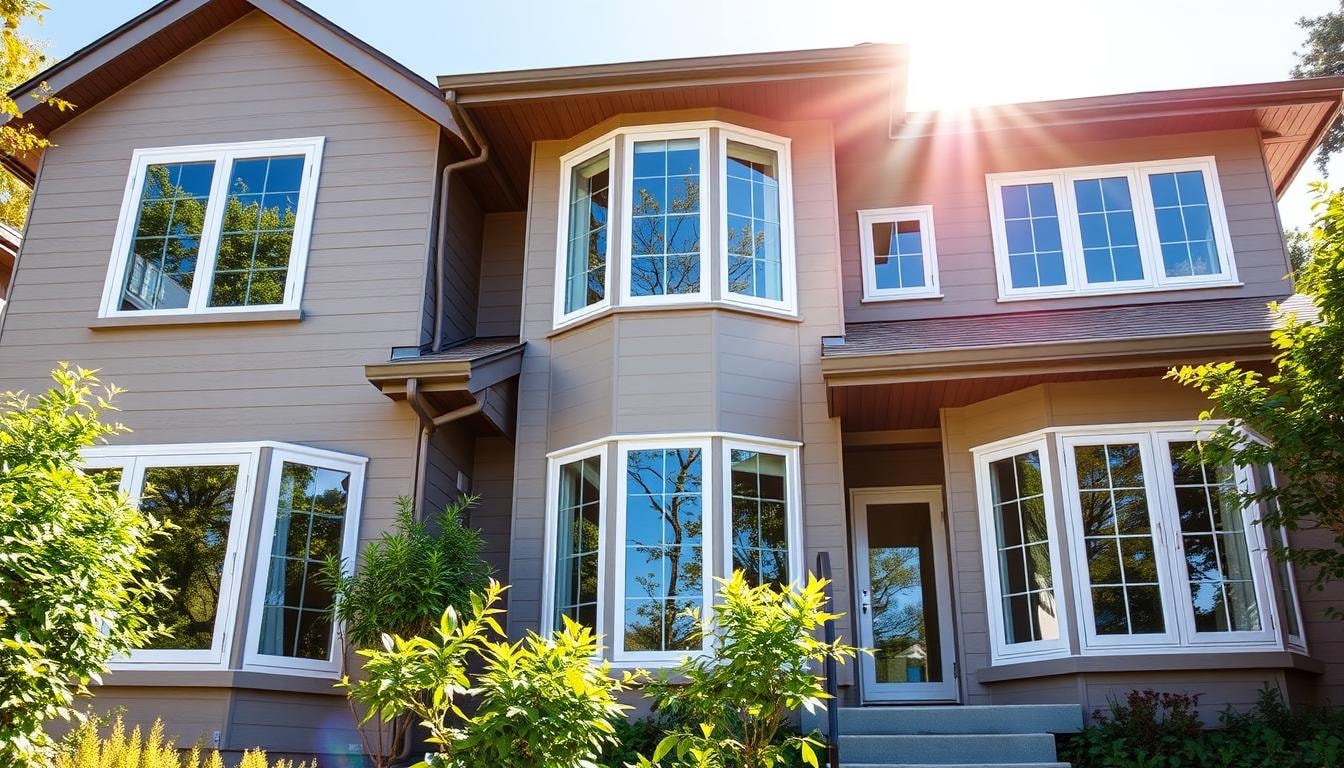
Energy Efficiency of Windows: A Complete Guide
Windows are key to a home’s energy use. They affect how much we spend on utilities, how comfortable we feel, and even if we get tax breaks. Energy-saving windows help keep your home warm in winter and cool in summer. They do this by using special glass and gas to block heat.
These windows often have more than one layer of glass. This setup helps keep your home’s temperature steady. The frames of these windows are also made to save energy. They can be made of vinyl or fiberglass, making them even better at keeping energy in or out.
How well a window saves energy depends on a few things. The number of glass layers matters a lot. Also, whether you can open the window and its size play a role. But, the best windows for saving energy have three layers of glass.
Key Takeaways
- Energy-efficient windows can reduce utility costs by 7-15% annually
- These windows offer up to 55% more energy efficiency than regular windows
- Proper window selection and installation are crucial for maximum energy savings
- Windows should have an Energy Rating (ER) of at least 34 to be considered energy-efficient
- The IRS offers up to $600 in tax credits for energy-efficient windows in the U.S.
Understanding Window Energy Efficiency Basics
Energy-efficient windows have special parts that help keep your home warm or cool. They have multiple glass layers, special gas fills, and frames that block heat. This makes your home more comfortable and saves energy.
Key Components of Energy Efficient Windows
The main parts of energy-efficient windows are:
- Multiple glass layers, often two or three panes, to reduce heat transfer
- Low-E (low-emissivity) coatings that reflect infrared heat while allowing visible light to pass through
- Inert gas fills, such as argon or krypton, between the glass panes to enhance insulation
- High-performance window frames made of materials like vinyl, fiberglass, or composite with lower thermal conductivity
How Energy Efficient Windows Work
Energy-efficient windows block heat from passing through. They use multiple glass layers, low-E coatings, and gas fills. This keeps your home at a comfortable temperature, saving on heating and cooling costs.
Benefits of Energy Efficient Windows
Installing energy-efficient windows brings many benefits:
- Lower energy bills by 12%
- Increased home value
- Improved indoor comfort
- Less noise
- Helps the environment
Knowing how energy-efficient windows work helps homeowners and builders. They can make their spaces more comfortable and energy-efficient.
ENERGY STAR Certification and Standards
The energy star program is run by the U.S. environmental protection agency. It sets high energy efficiency standards for products like windows. Windows must pass tough tests to get the energy star label.
Energy star certified windows are top-notch. They help homeowners save money on energy and are better for the planet. The agency checks many things, like how well the window keeps heat out or in.
The government gives a 30% tax credit, up to $600, for these windows. Some places also offer rebates for energy star windows and doors. This makes upgrading your home more appealing.
Choosing energy star windows can save you 12% on energy bills. That’s $200 to $600 a year. They also keep your home cozy by controlling heat better.
With the energy star label, you know your windows are energy-efficient. They are a smart choice for your home and the planet.
Critical Performance Ratings for Windows
Energy-efficient windows have key ratings that show their thermal and optical properties. These ratings, set by the National Fenestration Rating Council (NFRC), help you compare windows. They guide you in making smart choices.
U-Factor and Thermal Performance
The U-factor shows how well a window keeps heat in your home. A lower U-factor means better insulation and less heat loss. Energy Star windows can cut energy bills by 8% to 12%.
Windows labeled “Most Efficient” can be 40% more efficient than standard ones.
Solar Heat Gain Coefficient (SHGC)
The Solar Heat Gain Coefficient (SHGC) shows how much sunlight heat passes through. In warm places, a lower SHGC rating is better. It keeps your home cooler by blocking more solar heat.
Visible Transmittance and Air Leakage
Visible Transmittance (VT) shows how much natural light enters your home. Air Leakage (AL) rates how much air can get in. More VT means more light, less need for artificial lighting.
Lower AL ratings mean better sealing and fewer drafts.
By looking at these NFRC ratings, you can pick windows that save energy and improve comfort. This leads to lower bills and a more comfortable home.

Factors That Impact Performance
Energy-efficient windows have many factors that affect how well they work. The size of the window, the material of the frame, the type of glass, and the local climate are all important. These elements help keep the inside of your home comfortable and use less energy.
The size of a window matters a lot. Bigger windows are not as good at keeping energy in as smaller ones. This is because they have more surface area, which lets more heat out. The material of the frame also plays a big role. Vinyl, fiberglass, and wood frames are better at keeping heat in than aluminum frames.
The glass in the window is also very important. Double-pane or triple-pane windows with special coatings are better at keeping heat in. This makes the window more energy-efficient.
The local climate is also key when choosing windows. In cold places, you need windows that keep heat in well. In warm places, you want windows that keep heat out. This helps keep your home comfortable.
How well the windows are installed is also very important. If windows are not installed right, they can let air in and out. This can make them less energy-efficient. It’s important to make sure the windows are sealed well and insulated properly.
Types of Energy Efficient Windows
There are many energy-efficient window options. You can choose from double-pane to triple-pane windows. Low-E glass coatings also offer great benefits.
Double-Pane Windows
Double-pane windows have two glass sheets with air in between. This air space, filled with gases like argon or krypton, insulates better than single-pane windows. They are a popular, affordable choice for homes.
Triple-Pane Windows
Triple-pane windows have three glass layers with two air spaces. This setup insulates more, perfect for cold areas. They cost more but save on heating and cooling.
Low-E Glass Options
Low-E glass coatings are a big step in window tech. They reflect heat but let light in. They work well in all climates, saving energy.
Choosing the right energy-efficient windows is key. Look at U-factor, SHGC, and visible transmittance. This ensures your windows work best for your home and climate. Knowing your options helps you save money and stay comfortable.
Climate Zones and Window Selection
Energy-efficient windows vary by climate. The right window depends on your area’s weather. Knowing your climate helps choose windows that save energy and keep you comfortable.
In cold areas, pick windows with low U-factors and high SHGC. Double-glazed or triple-pane windows with Low-E coatings are great. They keep heat in and cut down on loss.
Warm climates need windows with low SHGC to stay cool. Tinted glass and frames like vinyl or fiberglass work well. They help keep the inside cool.
Mixed climates need a balanced solution. Use dual-action Low-E coatings that adjust with the seasons. Vinyl and fiberglass frames are good for all temperatures.
Choosing windows based on passive house principles and your climate makes your home more efficient. This way, you stay comfortable all year.

For the best results, get help from experts for window installation. They ensure your windows are sealed, insulated, and installed right. This unlocks their full energy-saving potential.
Installation Considerations for Maximum Efficiency
Getting your windows installed right is key to saving energy at home. While DIY might seem easy, it’s best to get pros to do it. They know how to measure, insulate, and seal to keep air out.
Common Installation Mistakes to Avoid
DIY mistakes can cause big problems. They might lead to air leaks, water damage, and even void your warranty. It’s important to avoid these to keep your windows working well.
Proper Sealing and Insulation Techniques
- Use weatherstripping to seal the window frame tight.
- Apply caulk or sealant to fill gaps and cracks.
- Insulate the frame well to stop heat from escaping.
Right installation is vital for energy-saving windows. Bad installs can cause air leaks and higher bills. Get pros or follow DIY best practices to keep your windows efficient.
Cost Considerations and ROI
Energy-efficient windows cost more upfront than regular windows. But, the long-term savings make them a smart choice. A medium-sized, triple-glazed casement window costs about $700. Replacing all windows in a house can cost between $6,685 and $33,425.
Government incentives like tax credits and rebates help cover the cost. In the U.S., homeowners can get up to $600 in tax credits for energy-efficient windows. The Energy Star program also offers a 30% tax credit, up to $600, for certain window upgrades from 2023 to 2032.
Homeowners should think about their energy bills and home condition when deciding. Energy-efficient windows can cut energy costs by $101 to $583 yearly. The average ROI for window replacements is about 67%.
In the end, investing in energy-efficient windows saves money over time. They reduce energy use, lower bills, and make homes more comfortable. Homeowners should compare the upfront cost to the long-term savings to choose wisely.
Contact Budget Windows for Expert Solutions
At Budget Windows, we specialize in providing top-quality energy-efficient windows and doors. Whether you need to replace existing windows or upgrade to energy-efficient options, our team of experts can guide you every step of the way. Contact us today to explore the best window types and frame materials for your home, and start saving on utility bills while reducing your carbon footprint. Let us help you make your home more comfortable and eco-friendly.
Conclusion
Energy-efficient windows are a great way to save money and make your home more comfortable. They help lower your energy bills and are good for the planet. Upgrading to ENERGY STAR® certified windows can save you $126 to $465 a year, says the U.S. Department of Energy.
The cost of new windows might seem high at first. But, the savings over time are worth it. Plus, they can make your home more valuable when you sell it.
Choosing the right energy-efficient windows is important. Think about your climate, the window’s rating, and how well they’re installed. New tech like low-E glass and gas fills make windows more efficient.
These windows also cut down on noise and protect your furniture from UV rays. So, they’re not just good for saving energy.
If you want to make your home more energy-efficient, consider energy-efficient windows. They’re a smart choice for saving money and helping the environment. By choosing energy-efficient options, you make your home more comfortable and eco-friendly.
FAQs
How do energy-efficient windows help reduce cooling energy?
Energy-efficient windows block the sun’s heat and minimize heat loss, helping to keep cooled air inside, reducing the load on your HVAC system.
What factors determine the energy performance of a window?
The energy performance depends on window glass type, frame material, and energy-efficient features like low-E coatings and gas fills between glass layers.
Are replacement windows worth the investment for improving a home’s energy efficiency?
Yes, replacing existing windows with energy-efficient options like vinyl windows can lead to long-term savings on utility bills and improved comfort.
How do frame materials, such as wood or aluminum windows, impact a window’s energy efficiency?
Wood windows have natural insulating properties, while aluminum windows may transfer more energy. Vinyl windows are highly efficient at minimizing heat loss.
What are the benefits of installing a patio door with energy-efficient features?
Energy-efficient patio doors reduce energy transfer, minimize heat loss, and help maintain a comfortable indoor temperature, which can lower utility bills.







